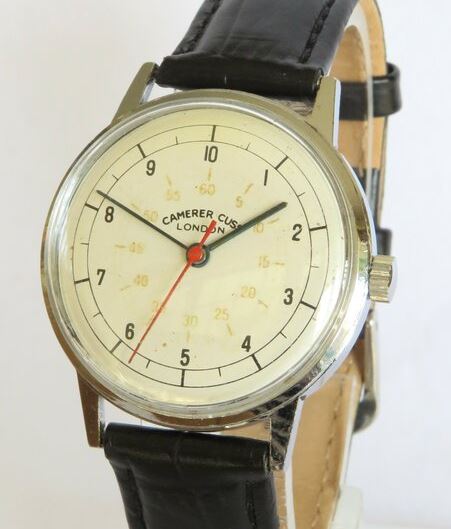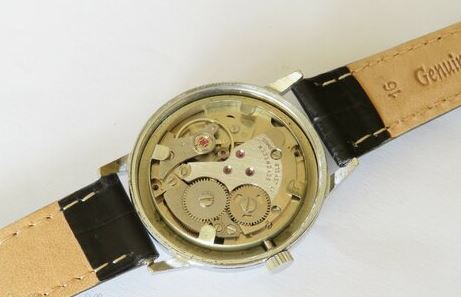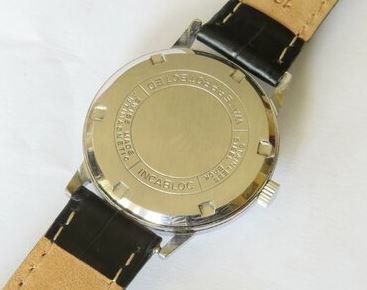Last Updated on June 29, 2024 by Jason
I came across this curious vintage timepiece when browsing The Vintage Wrist Watch Company. It is a 1970s metric or decimal wrist watch from the respected retailer Camerer Cuss. It is called decimal or metric because it only has 10-hour markers, which are subdivided into 100 minutes. I am not sure how practical this vintage decimal watch would be, but it certainly caught the interest of a collector, because it was sold before I could complete this research.
Decimal time
Every schoolboy knows that there are 24 hours in a day, 60 minutes in an hour, and 60 seconds in minute. However, in 1793, the French abandoned the old clock system in favour of French Revolutionary Time, which was a 10-hour day, with 100 minutes per hour, and 100 seconds per minute. The main benefit of this modern system was it allowed for a simplified way to do time-related maths. If we want to know when a day is 80% complete, decimal time simply says “at the eighth hour,” whereas standard time requires us to say “at 19 hours, 12 minutes”. French Revolutionary Time was a more elegant solution to that math problem. However, it didn’t really catch on as an idea, because people were used to the time-tested method they had been using for all of their lives.

French Revolutionary Time officially began on 24 November 1793, although work around the concept had been going on since the 1750s. The French manufactured clocks and watches showing both decimal time and standard time on their faces, which must have confused a lot of people. The concept proved unpopular. The French officially stopped using decimal time after just 17 months. French Revolutionary Time became optional starting on 7 April 1795.
20th century
After that disastrous experiment, we step forward 150 years or so. Gas boards used decimal watches because they measured time in decimal units for practical purposes. In certain industries, like gas or utilities, work was often billed in hundredths of an hour, which aligns with a decimal time system. This made calculations simpler and more accurate for billing and record-keeping. Decimal watches have indices for 100 minutes instead of 60, which corresponds to the decimal system of timekeeping. This system, although not widely adopted, provided a logical approach to timekeeping in a base-10 system, which is generally used in mathematics and science1. However, it’s important to note that the decimal time system has been proposed several times throughout history but has never gained widespread acceptance.
Camerer Cuss & Co.
Camerer Kuss & Co were a well-respected London watch and clock retailer. The company survived in some form up until 2002. There are dozens, if not hundreds, of Camerer & Kuss timepieces for sale online. Despite such a presence, the history of the company is sketchy at best. I couldn’t find a single definitive online source for the company’s history. Additionally, many of the brief outlines I discovered were contradictory. Therefore this is going to be a composite sketch of what I think is the history of Camerer Kuss & Co. From what I read online, the company is very well respected and their timepieces are considered to be of good quality.
In the 1780s the Camerer and Kuss families were farmers in the Black Forest in Germany. They joined forces and began watchmaking as part of the local cottage industry. At some point around 1788 at least one member of each family emigrated to London and formed Camerer Kuss & Co. Although, promoting themselves as watch and clockmakers, they would simply have been purchasing the movements and assembling the watches with their brand.
Name change
In 1845, Andrew Camerer and David Kuss, both descendants of the original owners, were operating a thriving business. A key part of this was importing Black Forest clocks from Germany. In 1867 the firm opened a retail outlet and workshop at 522 Oxford Street. The shop eventually had several London branches, some of which specialised in selling jewellery. At the beginning of the First World War, there was ill-feeling towards anybody with a German-sounding name. As a result, the spelling of the family name was changed to Cuss.
Movement
This vintage watch has a Swiss 17-jewel hand-winding movement with Incabloc shock protection. The watch is keeping good time. The movements used in decimal watches were similar to those in standard watches. However, there were modifications to accommodate the decimal timekeeping system. Both types of watches can have mechanical movements, which include a series of gears and a mainspring to measure the passage of time. However, the dial train in a decimal watch would be calibrated to divide an hour into 100 decimal minutes, rather than the 60 minutes of a standard watch. This means that while the fundamental mechanics were similar, the way they displayed time was different to align with the decimal system.

Case and dial
The watch measures 32.5mm in diameter excluding the winding crown and the lugs. The case is chrome plated while the screw-on case back is stainless steel. The case is in good condition, just light wear but nothing serious at all. The screw-on case back states that the watch is “water protected” but, as with any vintage watch, it should be kept away from water and moisture. The lens has light markings if viewed closely.
The signed dial is in its original finish with decimal, or metric, markers which divide the day into 10 decimal hours. The dial also has a red inner dial, which has faded over time. The inner dial has the conventional 60-minute markers so the time can still be read in the usual way. Original hands and red seconds sweep.
The dial is signed “Camerer Cuss”, the famous London jeweller and original retailer of this watch. The watches were issued to employees of the Gas Boards for fieldwork.

Summary
It is an interesting vintage watch and I enjoyed several hours researching the decimal watch concept. I am not sure how practical it would be to use. However, I guess it would be an interesting talking point in any vintage watch collection. Maybe I will get another chance to consider a vintage decimal watch in the future.
Leave a Reply